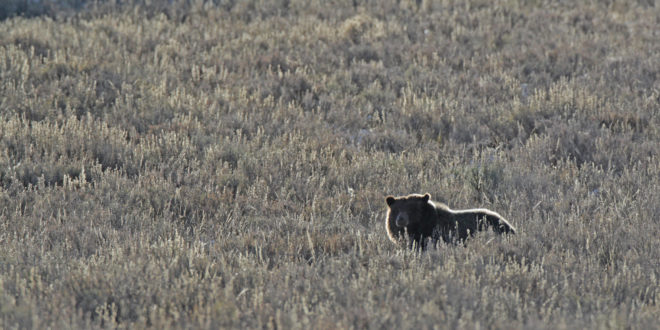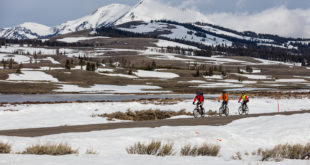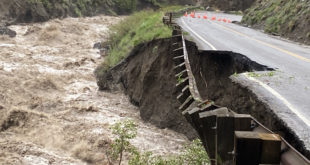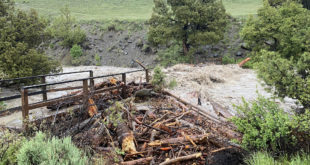Yellowstone and Montana officials are taking stock of Wyoming and Idaho’s decision to pursue hunting seasons on grizzly bears.
Idaho has proposed a season on one male grizzly, while Wyoming wants to sell up to 24 grizzly tags.
Montana, meanwhile, has declined to host a grizzly hunting season this year, citing ongoing litigation against the U.S. Fish and Wildlife Service (USFWS).
The USFWS stripped endangered species protections from Yellowstone-area grizzly bears in June 2017, following over two years of debate. Management turned over to the states in August 2017. Shortly after the decision came, several environmental and Native American groups announced they would sue the USFWS, arguing the decision is premature and puts the population at risk. So far, over six groups have sued the USFWS.
According to the Bozeman Daily Chronicle, Yellowstone and Montana officials are downplaying the risk hunting poses to the population currently:
Yellowstone National Park spokeswoman Morgan Warthin said Friday that the park didn’t have any concerns. Frank van Manen, the leader of the Interagency Grizzly Bear Study Team, said kill limits enshrined in the management guidelines should ensure any impact to the population will likely be “pretty minor.”
But critics are worried that the proposed hunts threaten the newly delisted grizzly population. Andrea Santarsiere, an attorney with the Center for Biological Diversity, worries Idaho’s hunters might accidentally kill a female, which she says could break an agreement between the states. David Mattson, a former government scientist turned grizzly bear advocate, wrote in a blog post earlier this month that Wyoming’s plans would likely “increase risks for a population that is already vulnerable.”
Wyoming’s proposal even has critics among those who supported delisting, like Dan Vermillion, the chairman of Montana’s Fish and Wildlife Commission.
“I worry that something like the Wyoming decision has probably given the people who want to stop the delisting … the best argument they could have,” Vermillion said. “I think Wyoming’s proposal is going to be a challenge.”
[…]
Bonnie Rice, of the Sierra Club, said in a statement this week that Wyoming’s proposal is “extreme and irresponsible” and that killing females could have an impact on reproductive rates.
Nick Gevock, conservation director for the Montana Wildlife Federation, a delisting supporter, said Wyoming’s proposal is a bit much.
“I think it’s a very aggressive hunt for the first year,” Gevock said. “The species just came off the endangered species list.”
Satarsiere also highlighted the risk an Idaho hunter could kill a female grizzly, which would upset the agreement made among Idaho, Wyoming, and Montana.
Under the current management agreement, only a set number of grizzlies can be taken in the “Demographic Monitoring Area,” an approximately 20,000 square mile zone that includes Yellowstone and Grand Teton National Parks. Wyoming has proposed offering half its proposed tags for within the DMA with the other half offered in areas outside the DMA.
Hunting, of course, is prohibited in national parks. To that end, Wyoming has prohibited grizzly hunting in certain areas outside Grand Teton, as well as within sight of highways.
Chief Wyoming Game and Fish warden Brian Nesvik countered criticism by saying the state’s grizzly hunting proposal is biologically sound and based on public feedback.
Grizzly advocates argue the risk against grizzlies is too high to warrant hunting of any kind. Further, some advocates argue the bears can’t be considered recovered under the Endangered Species Act unless they reconnect with other grizzly populations around the country, most notably the grizzlies living in the Northern Continental Divide Ecosystem in northern Montana.
This issue of subpopulations is at the heart of current litigation against the USFWS. Indeed, the agency said in December 2017 it would voluntarily review its grizzly decision following a court ruling on Great Lakes wolves. In said ruling, a federal judge held the agency erred in stripping endangered species protections for the wolves, arguing the agency had to consider the impact selective protection removal would have on the wolf population as a whole.
Plaintiffs in the grizzly suit quickly incorporated this ruling into their arguments, calling on a federal judge to invalidate the USFWS’ grizzly decision.
Currently, a hearing on the grizzly case is scheduled for August 2018, just before the tentative start of any hunting season. U.S. District Judge Dana Christensen of Missoula, MT will preside.
 Yellowstone Insider Your Complete Guide to America's First National Park
Yellowstone Insider Your Complete Guide to America's First National Park





